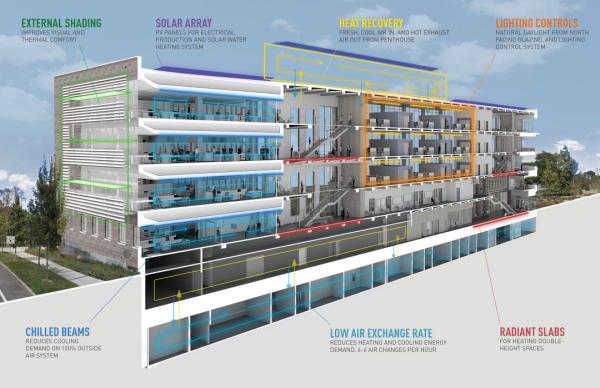Image credit: Lake | Flato Architects – Georgia Tech Engineered Biosystems Building
Welcome and long overdue, the American Institute of Architects (AIA) has recently expanded on Canon VI, Obligations to the Environment, in the 2018 Code of Ethics and Professional Conduct. This may not sound earth-shattering, but in fact it's quite a meaningful milestone: for the first time, disciplinary action could be taken against a member found to not have considered the environmental effects of their project decisions with their clients as required in Rule 6.501. The related Ethical Standards outline specific goals toward which Members should aspire in professional performance and behavior and include:
E.S. 6.1 Energy Conservation
Members should set ambitious performance goals for greenhouse gas emission reduction with their clients for each project.
E.S. 6.2 Water Use
Members should optimize water conservation in each project to reduce water use and protect water supply, water quality, and watershed resources.
E.S. 6.3 Building Materials
Members should select and use building materials to minimize exposure to toxins and pollutants in the environment to promote environmental and human health and to reduce waste and pollution.
E.S. 6.4 Ecosystems
Members should consider with their clients the impact of each project on the natural habitat and ecosystem to promote environmental and human health.
E.S. 6.5 Climate Change
Members should incorporate adaptation strategies with their clients to anticipate extreme weather events and minimize adverse effects on the environment, economy and public health.
Hear, hear! We feel fortunate to work with many architects who already embrace these aspirations and see thoughtful consideration of sustainability as a critical responsibility of their profession. On the other hand, we have worked with at least one client who's practically bragged about designing something irresponsible in terms of energy efficiency and thermal comfort but still eked by the code.
Why do that when we can have both: gorgeous and creative details and focal points in a building that are aligned with responsible environmental standards, don't cause uncomfortable hot or cold spots, and don't overcomplicate HVAC design. Constraints are the conditions for creativity, and we love to work with architects who are excited by this challenge!






























